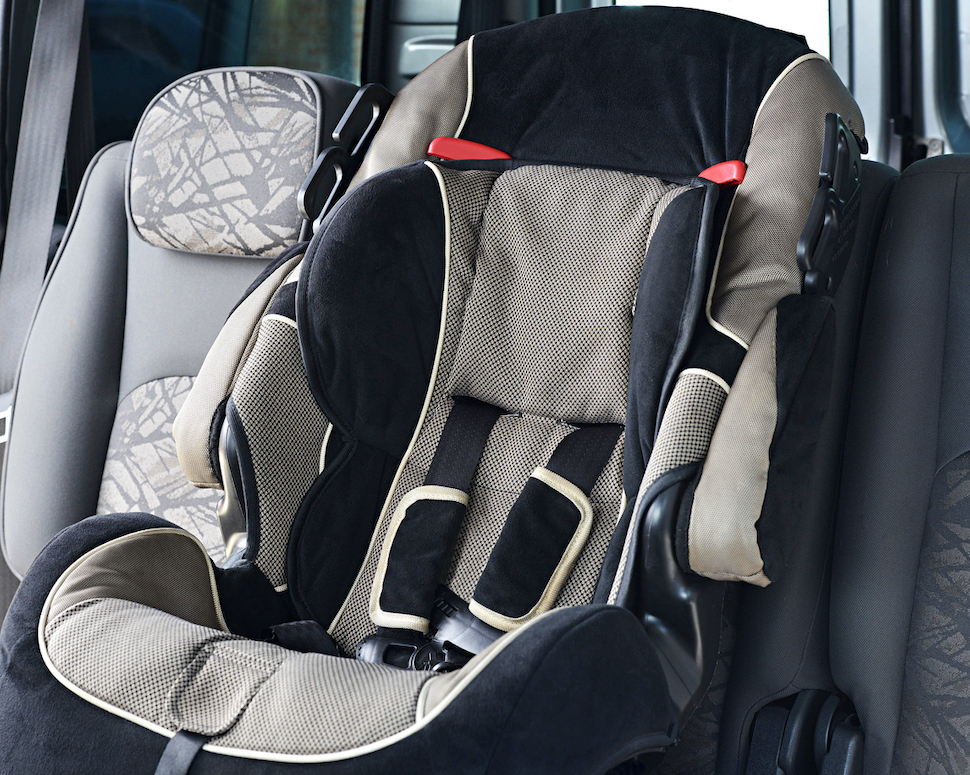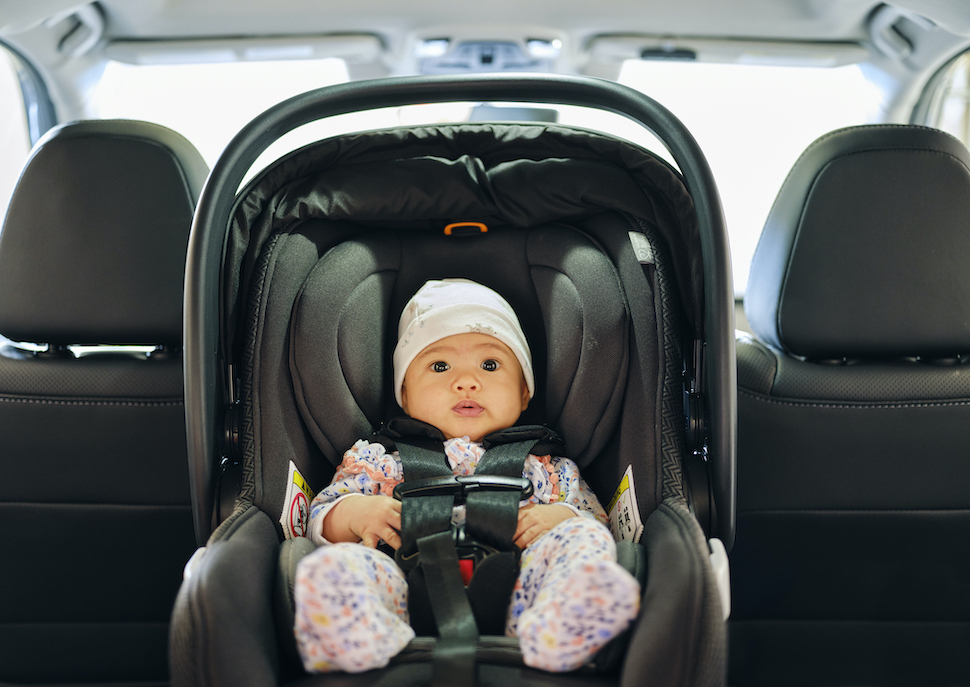Table of Contents
Congratulations!!! You just had your beautiful new baby. And found your favorite baby car seat. Now where in the car do you actually secure it? Where’s the safest possible place for your new baby to be seated, secured and strapped in?
We’ll look at 3 scientific studies that’ll answer that for you, leaving you confident and comfortable, and leaving your baby safe, snug, and sound.
Science Has Spoken
- “Unrestrained children in the front were at the highest risk of injury and appropriately restrained children in the rear were at the lowest risk, for all age groups.”2
- “Forty percent of all of the crashes were side impacts, and in all fatal side impact crashes there was intrusion at the child’s seating position.”1
- “Children seated in the center rear have a 43% lower risk of injury compared with children in a rear outboard position.”3
So, What’s the Safest Place for a Baby Car Seat?
THE SAFEST PLACE FOR YOUR BABY IN A CAR IS THE MIDDLE OF A BACK SEAT, IN A REAR-FACING, PROPERLY INSTALLED BABY SEAT, INTO WHICH YOUR BABY IS PROPERLY SECURED.1,2,3
Let’s look at the science behind this.
Study: 40% of All Fatal-to-Child Car Crashes Involved SIDE IMPACTS to a Vehicle1
In a broad 2003 study, researchers reviewed detailed reports of car crashes that killed 92 children throughout the year 2000. These were children in a child restraint at the time of the crash.
Researchers obtained census data of fatal crashes occurring on U.S. public roads for the year and whittled this down to better understand how and why: 621 fatal crashes had occurred involving children younger than age six. 23% (143) of the children had been in child restraints at the time of the fatal accident. So investigators contacted local police departments and sheriff offices for detailed information on these cases. From the original 143 fatalities involving child restraints, they were able to obtain data on 92 of the fatalities.
- 68% of the children in accidents that ended up fatal were in outboard positions of back seats*
- 15% of children in accidents that ended up fatal were in middle rear positions
- * In 70% of fatal crashes, the child was seated on the side of the vehicle that was struck in the accident. There is no official statistical difference in what side of a car is most often struck in a crash, however it is thought to be the right side of the vehicle due to: A) The driver, seated at left, subconsciously protects himself, and B) Wide left turns across multiple lanes expose the right side of the vehicle to more danger from the traffic the driver is passing, joining or merging into.
“Forty percent of all of the crashes were side impacts, and in all fatal side impact crashes there was intrusion at the child’s seating position.”
“Side impacts accounted for the largest number (40 percent) of fatalities; in 70 percent of these crashes, the child was seated on the struck side.”
(Source: Study, “Factors Leading to Crash Fatalities to Children in Child Restraints.”)
Study: Appropriately Restrained Children in a REAR CAR SEAT Have The Lowest Risk in an Accident2
In a 2005 study, researchers analyzed more than 11,500 car crashes that involved nearly 18,000 children. Four years’ worth of data, 15 states’ worth of crashes (total accidents was 146,613 involving children under 16-years-old; sample size was 11,500 accidents.)
Conclusion: “Unrestrained children in the front were at the highest risk of injury and appropriately restrained children in the rear were at the lowest risk, for all age groups.”
Your car likely also tells you this. The 2020 KIA Sportage for instance includes a permanent notice , “The back seat is the safest place for children,” while its owner’s manual says “All children under age 13 should ride in your vehicle properly restrained in a rear seat, not the front seat.”
In the 2003 study we mentioned earlier, researchers likewise found the same: Any child-restraint reduced chances of fatality by 39%.
In 2001, 39% of fatally-injured child occupants were reportedly unrestrained. No matter how far you’re traveling or how short the drive, buckle baby up every single time.
(Source: Study, “Effects of Seating Position and Appropriate Restraint use on the Risk of Injury to Children in Motor Vehicle Crashes.”)
Study: Children Seated in the CENTER REAR SEAT have a 43% Lower Risk of Injury3
We now know that the back seat is far safer for a child than the front seat. But does it matter where in the back seat you install your child seat? Yes! Compared with children seated on the outside edges of the rear seat (left or right side), children in the center of the rear seat had a 43% lower risk of injury.
In a 2008 study, researchers with the University of Pennsylvania School of Medicine looked at 8 years’ worth of car accidents that involved children aged 0 to 3 in 16 U.S. states.
Their conclusion? “Children seated in the center rear have a 43% lower risk of injury compared with children in a rear outboard position.”
(Source: Study, “Seating Patterns and Corresponding Risk of Injury Among 0- to 3-year-old Children in Child Safety Seats.”)

After countless nights of poor sleep, exhaustingly leaning deep into your car for the 10th time in a day, your back aching as you tackle all that being a new mother involves, you’re going to question it. Is it actually worthwhile?
Please don’t.
I know it’s hard.
But it’s worth 100% of the effort.
You got this. Good luck and safe driving!
References:
- Sherwood, C. P., Ferguson, S. A., & Crandall, J. R. (2003). Factors leading to crash fatalities to children in child restraints. Annual proceedings. Association for the Advancement of Automotive Medicine, 47, 343–359.
- Durbin, D. R., Chen, I., Smith, R., Elliott, M. R., & Winston, F. K. (2005). Effects of seating position and appropriate restraint use on the risk of injury to children in motor vehicle crashes. Pediatrics, 115(3), e305–e309. https://doi.org/10.1542/peds.2004-1522
- Kallan, M. J., Durbin, D. R., & Arbogast, K. B. (2008). Seating patterns and corresponding risk of injury among 0- to 3-year-old children in child safety seats. Pediatrics, 121(5), e1342–e1347. https://doi.org/10.1542/peds.2007-1512


